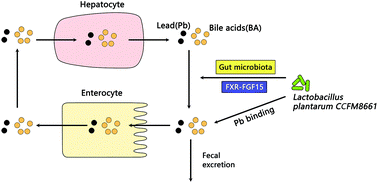Lactobacillus plantarum CCFM8661 modulates bile acid enterohepatic circulation and increases lead excretion in mice†
Abstract
The management of lead (Pb) exposure and toxicity remains a major public health priority worldwide. In our previous study, the probiotic strain Lactobacillus plantarum CCFM8661 prevented Pb absorption in mice via intestinal sequestration. This follow-up study aimed to evaluate the additional protective mechanism of L. plantarum CCFM8661 with a focus on its regulation of enterohepatic circulation. We first confirmed the relationship between the enterohepatic circulations of Pb and bile acid (BA) by administering a BA sequestrant, cholestyramine, to mice with a high Pb burden. Our data further showed that L. plantarum CCFM8661 significantly induced hepatic BA synthesis, enhanced bile flow and biliary glutathione output, and increased fecal BA excretion in the mice, which in turn increased biliary Pb output and enhanced fecal Pb excretion. This regulation was associated with the alterations in the expression of target genes in the enterohepatic farnesoid X receptor–fibroblast growth factor (FXR–FGF15) axis and could be reversed using an FXR agonist, GW4064. Pre-treatment with antibiotics also abolished the L. plantarum CCFM8661-induced effects on BA and Pb enterohepatic circulation. These results suggest that L. plantarum CCFM8661 induces fecal Pb excretion by regulating BA enterohepatic circulation. This regulation is associated with the down-regulation of the FXR-FGF15 axis and is partly dependent on the gut microbiota of mice.



 Please wait while we load your content...
Please wait while we load your content...